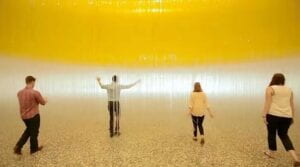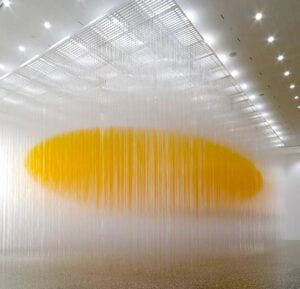In the midterm project, my partner and I designed some new playing methods based on the game “Truth or Dare”. Two players are involved in the game, having a competition on their speed to shake the clapping toy and on their luck. In my opinion, interactive means communication between the artifact and the users, or between users and users. From the article, I know more about interactive and different levels of art: Dynamic-Passive: the simple reaction of the artifact, which its output is completely predictable; Dynamic-Interactive: the interactive artifact that can deliver its output to the users, making the user think and change their input actions; Dynamic-Interactive (Varying): the highest level is that the work is unpredictable and interactive. It will learn experience and adjust its output, which adds more random and interesting functions to the performance.
(Ernest Edmonds, Art, Interaction and Engagement).
I am inspired by the game I played named “Osu!”. It is a great rhythm game, combining the music with clicking, tapping keyboards, and moving the mouse. I like the “osu! mania” mode in this game. In the game, the key notes appear in the form of squares, and the moment the squares hit the line, the player should immediately press the corresponding button to get a “combo” (“perfect”). If the error between the key pressing and the rhythm of the original song is larger, the “perfect” will become “good”, “bad” or “miss” displayed (the error will reduce the accuracy rate and the song score).”The map of the music is then played with accompanying music, simulating a sense of rhythm as the player interacts with the objects to the beat of the music.” (Wikipedia. https://en.wikipedia.org/wiki/Osu!)
When playing osu, I am completely immersed in the music. If I got a “miss” or “bad” mistake, I will immediately adjust my pace, it is interactive. Although this game looks simple compared to other games, this simple style and interactive playing method inspired me. In the final project, I may also try adding some combinations of music and physical control to make the game more interesting.
(The video I recorded myself playing the game.)
The other project is the artifact designed by Venezuelan artist Jesús Rafael Soto (1923 – 2005), made of colorful linear materials, appears to be a monolith, but the interior is free to travel, allowing visitors to enter this magical space, move freely, play, and enjoy as if they could touch the golden sunlight. The combination of linearity forms different shapes visually. The visitors also can travel through it, which is very attractive. If the linear combination can change with people’s movement, and position, it will be more interactive as Dynamic-Interactive. If the artifact can use some algorithmic to learn experiences from the users, and depending on the history of interactions with users, performing and modifying its specification, it will be more interactive and interesting.
The pictures:

